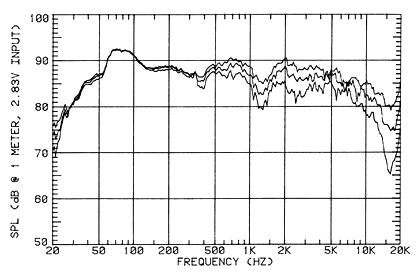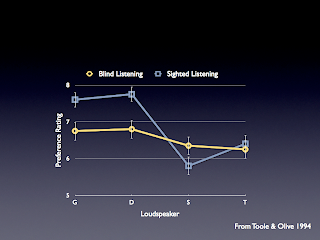All? No. And there is nothing about what people "buy." People buy for many reasons beside audio quality. And that is part of the problem they have tried to solve. By putting the speakers behind curtains, they eliminate anything but the notion of the comparative sound quality as judged by listeners. I have sat through that test twice with a group of others. In every case, majority votes for the speakers that have the best measurements and the same as what you see in the chart (even though the speakers do change). Clearly there is a common thread there as far as what we prefer as good sound. Think about it. That is what you do when you go to buy a speaker. You listen and decide on fidelity. The only difference here is that they don't let you see the brand, price, and look of the product. And they show you alternatives in the exact same spot. These are things that you cannot do when you go t a stereo store.
They use the word preference. That causes people to automatically decide that they are measuring taste. It is not so. If it were taste, then the results would not converge as highly as it does. Importantly, the measurements highly correlate with listening tests. What we think should be good, flat frequency response (combined direct and indirect) is what wins most of the time. We know we all hear frequency response variations. So the fact that this becomes a requirement for good sound, makes all the sense in the world.
When I sat through the test, and I listened, at first you are taken back that the task is hard in there is no true reference. You do have flavor A against flavor B. But the speaker that is designed by science, sounds more natural. It sounds more real. So you vote for that.
Speaker "B" is the B&W 702N. It has a dip in its overall sound in the 2K to 3K range. This is because there is too big of gap between its woofer size and tweeter. What makes it a marketing hit with that distinct look, does have a price. As the frequencies go up, the woofer gets too directional. Yet the frequency is too low for the tweeter to pick up. Eventually the tweeter does pick up the load and then all of a sudden the speaker becomes less directional so its response off axis goes up/gets better. But the damage is done in the most critical region of our hearing, the 2K to 3K range. So vocals, when compared to a speaker that doesn't have that dip, don't sound as good.
To me, when we have listening tests with science and measurements, then we have a very compelling case as our baseline. Put another way, you have to start believing something about the science. And that is a great starting position. There may be better religion, but it has the responsibility to prove that by changing the rules, it can still succeed. This is what I love about Dr. Toole's work. He creates and entire end-to-end story that hangs together. It may not be perfectly right. But it is a hell of a lot better position to start with than randomly assigning goodness to speakers.
The work that Dr. Toole did was a good intellectual exercise. If I herd a bunch of people into a room and get to select 4 speakers for them to listen to and grade, unless they are deaf, I should be able to have the people reach some type of consensus on which speaker sounds *best* if the other three I have chosen have obvious problems like the example you cited.
But what happens now if I choose 4 speakers that were all intelligently designed, have super high quality parts, and all measure extremely well? Are we now going to have consensus from the gathered masses on one out of the four speakers sounding the best? I doubt it. Because four different speakers from four different manufacturers are never going to sound the same and it will come down to a preference.








